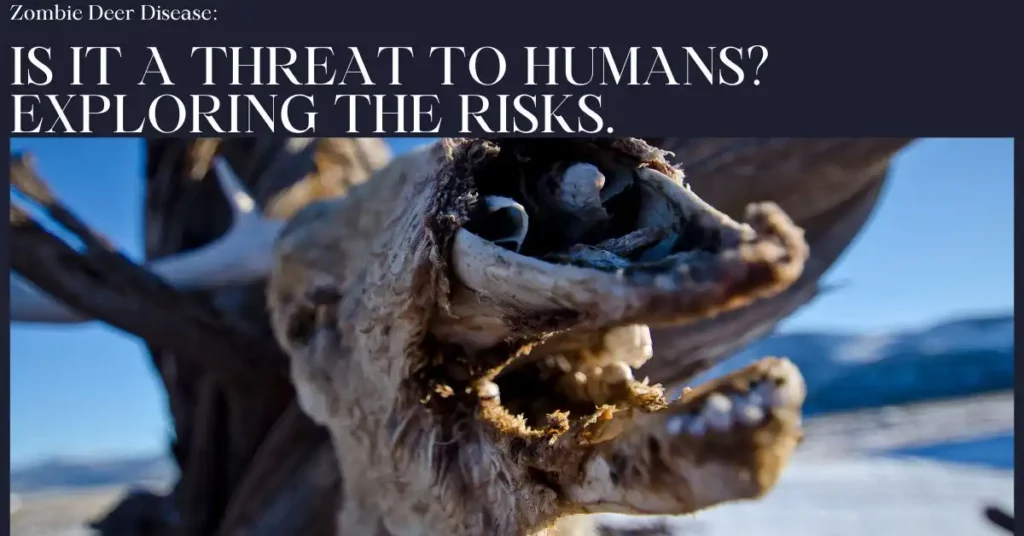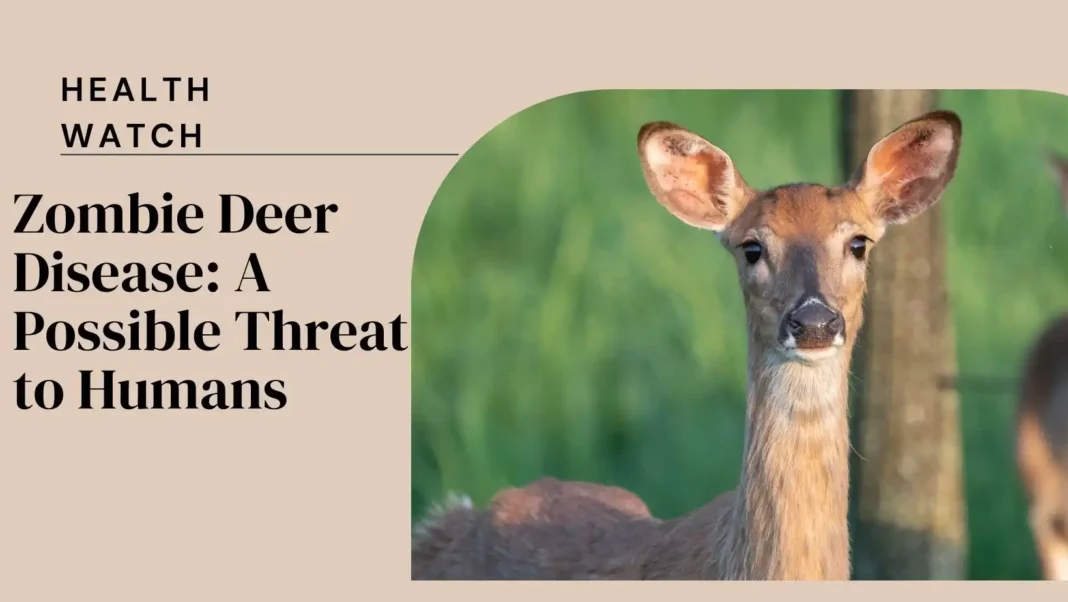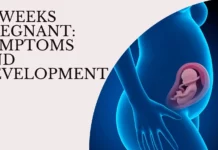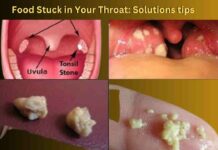What is Zombie Deer Disease

Zombie Deer Disease, also known as Chronic Wasting Disease (CWD), is a fatal neurological disease that affects deer, elk, reindeer, sika deer, and moose. It is one of a group of diseases caused by prions, which are abnormal proteins that cause other proteins in the brain to fold incorrectly.
This disease slowly damages the brain alongside the nervous system of the animal, resulting in severe neurological symptoms. Affected animals exhibit symptoms such as wasting, stumbling, behavioral changes, drooling, excessive thirst or urination, lack of fear of humans, and other neurological issues.
CWD has been identified largely in certain regions of North America, including Canada and the United States, as well as countries such as Norway and South Korea. The disease’s reported cases have increased, with Wyoming being an important hotspot.
One of the major concerns about CWD is its ability to spread to humans. While no confirmed cases of CWD transmission to humans have been reported as of the most recent updates, health experts and scientists are concerned about the disease’s difficulty and the potential risks of spillover events. Similar animal diseases, such as mad cow disease (Bovine Spongiform Encephalopathy, or BSE), have been linked to human prion disease variants.
CWD has a long incubation period, often lasting more than a year before symptoms appear in infected animals. Because of the lengthy incubation period and prions’ resistance to conventional sterilization methods, controlling and eradicating CWD once it enters an environment becomes extremely difficult.
Symptoms in affected animals: weight loss, neurological issues, and behavioral changes

Chronic Wasting Disease (CWD), also known as Zombie Deer Disease, manifests various symptoms in affected animals, which can include:
- Weight Loss: One of the primary symptoms observed in animals affected by CWD is significant and progressive weight loss. The affected animals experience wasting, which refers to a substantial decline in body mass and condition over time.
- Neurological Issues: CWD primarily affects the brain and nervous system of infected animals. As the disease progresses, it leads to a range of neurological problems. These issues can manifest as stumbling, lack of coordination, and abnormal movement patterns such as staggering or difficulty walking properly.
- Behavioral Changes: Infected animals may exhibit notable changes in behavior. This could include altered or abnormal behavior compared to their typical patterns. Some animals may appear disoriented, confused, or display unusual behaviors not typical for their species. Additionally, they might demonstrate a lack of fear towards humans, which is atypical behavior for these wild animals.
These symptoms collectively contribute to the characterization of Chronic Wasting Disease. It’s important to note that these signs might not be immediately noticeable and could take an extended period to become apparent in infected animals due to the disease’s long incubation period. Early detection of CWD in wildlife populations is crucial for surveillance and management efforts to prevent further spread of the disease.
Concerns and Potential Risks to Humans
The concerns and potential risks regarding Chronic Wasting Disease (CWD) is relation to humans revolve around the possibility of transmission and its potential impact on human health. Here are the primary concerns and risks associated with CWD:
- Zoonotic Potential: While there have been no confirmed cases of CWD transmission to humans as of the latest information available, concerns persist regarding the potential for the disease to cross species barriers. Similar diseases in animals, such as mad cow disease (Bovine Spongiform Encephalopathy or BSE), have resulted in variants affecting humans (e.g., variant Creutzfeldt-Jakob Disease). This raises concerns about the zoonotic potential of CWD.
- Transmission Pathways: The exact mechanisms or pathways through which CWD could potentially infect humans are not fully understood. However, prion diseases like CWD are known for their ability to adapt and infect different species, which heightens concerns about potential exposure pathways to humans.
- Long Incubation Period: CWD has a notably long incubation period, often taking years before symptoms manifest in infected animals. This prolonged latency period raises worries about delayed onset in humans if transmission were to occur, making it challenging to identify and trace cases back to the source.
- Health Risks and Impact: Prion diseases like CWD are incurable and fatal once symptoms appear. If CWD were to cross the species barrier to humans, it could lead to severe neurological disorders and potential fatality. The impact on public health, should transmission occur, could be substantial due to the lack of effective treatments or vaccines.
- Precautionary Measures: Health authorities and experts emphasize the importance of precautionary measures to mitigate potential risks. Recommendations include avoiding contact with or consumption of meat from visibly sick or dead deer and elk, minimizing exposure to specific tissues (such as brain or spinal cord tissues) during hunting or processing, and following proper hygiene practices.
Given the uncertainty surrounding the potential for CWD transmission to humans, ongoing surveillance, research, and adherence to recommended preventive measures remain crucial to mitigate and prevent any possible risks to human health.
Studies and Warnings on CWD Transmission
Studies and warnings regarding Chronic Wasting Disease (CWD) transmission focus on the potential risks associated with this prion disease in various animal species and the concerns regarding its possible transmission to humans. Here are key points related to studies and warnings concerning CWD transmission:
- Non-Human Primate Studies: Research and studies have raised concerns about the potential transmission of CWD to non-human primates, such as monkeys. Certain experiments involving the exposure of non-human primates to infected tissues or consumption of infected meat have suggested the possibility of CWD transmission to these animals.
- Risk to Humans: While there have been no confirmed cases of CWD in humans, studies and findings related to non-human primates raise concerns about the potential risks to human health. The World Health Organization (WHO) has cautioned against the entry of prion agents from known prion diseases into the human food chain since 1997.
- Transmission Routes: Studies aim to understand the possible routes through which CWD could potentially cross the species barrier to infect humans. These investigations explore the transmission pathways, the stability of prions in the environment, and the mechanisms that might enable interspecies transmission.
- Precautionary Measures: Based on these findings, health authorities and experts stress the importance of implementing precautionary measures. Recommendations include avoiding the consumption of meat from animals infected or suspected of having CWD, minimizing contact with specific tissues (such as brain or spinal cord tissues) during hunting or processing, and maintaining proper hygiene practices when handling potentially infected animals.
The studies and warnings concerning CWD transmission underscore the need for ongoing research, surveillance, and adherence to preventive measures to mitigate potential risks and safeguard both animal and human health from the possible consequences of this prion disease.
Challenges in Eradicating Zombie Deer Disease
Eradicating Chronic Wasting Disease (CWD), also known as Zombie Deer Disease, poses significant challenges due to various factors related to the nature of the disease and its environmental persistence. Here are the primary challenges associated with eradicating CWD:
- Long Incubation Period and Asymptomatic Carriers: CWD has a prolonged incubation period, often taking years before infected animals show symptoms. During this incubation period, animals can spread the disease without exhibiting signs, making it challenging to detect and control the spread.
- Environmental Persistence: CWD prions have the ability to persist in the environment for extended periods. The infectious prions remain in soil, plants, and surfaces, making it difficult to eliminate them even after infected animals have left the area. The resistance of CWD prions to standard sterilization methods, such as disinfectants, heat, and radiation, adds to the challenge.
- Lack of Effective Treatment or Vaccine: There are currently no known treatments or vaccines available for CWD in either animals or humans. The absence of effective measures to treat or prevent the disease complicates eradication efforts.
- Wildlife Management Challenges: Implementing control measures for CWD in wild animal populations is challenging due to the vast geographical spread of infected animals, the difficulty in identifying carriers, and the free-ranging nature of deer, elk, and other susceptible species.
- Resource Constraints: Eradicating CWD requires significant resources, including funding for research, surveillance, and control measures. Limited resources and competing priorities can hinder comprehensive efforts to combat the disease effectively.
- Complexity of Transmission Pathways: Understanding the intricate pathways through which CWD spreads among animal populations and the potential risk factors associated with transmission complicates eradication strategies.
- Global Spread and Lack of Uniform Strategies: CWD has been identified in various regions across different countries, leading to varying control and management strategies. The lack of uniformity in approaches makes coordinated efforts to eradicate the disease challenging.
Addressing these challenges requires collaborative efforts among researchers, wildlife managers, government agencies, and communities. Strategies aimed at surveillance, research, implementing preventive measures, and fostering public awareness are essential to mitigate the spread and impact of CWD on animal and human populations.
Preventive Measures and Recommendations
Preventive measures and recommendations play a crucial role in minimizing the risk of exposure to Chronic Wasting Disease (CWD) and mitigating its potential transmission to humans. Here are key preventive measures recommended by health authorities and experts:
- Avoidance of Infected Animals: Refrain from shooting, handling, or consuming meat from deer, elk, or other cervids that appear sick, exhibit unusual behavior, or are found dead (such as road-kill). Visual cues indicating potential infection include emaciation, stumbling, or abnormal neurological symptoms.
- Protective Gear and Hygiene Practices: When handling potentially infected animals, use latex or rubber gloves as a protective measure. Minimize direct contact with specific tissues, particularly the brain or spinal cord tissues, during field dressing or meat processing. Additionally, avoid using household knives or kitchen utensils for field dressing to prevent potential contamination.
- Limiting Exposure to Specific Tissues: Minimize contact with high-risk tissues, such as the brain, spinal cord, eyes, spleen, and lymph nodes, which tend to have higher concentrations of infectious prions.
- Safe Handling and Processing: Adhere to proper hygiene practices during hunting, dressing, and processing of game meat. Thoroughly clean and disinfect equipment used for field dressing and processing game meat to reduce the risk of prion contamination.
- Public Awareness and Education: Raise awareness among hunters, wildlife enthusiasts, and the general public about the signs of CWD in animals and the importance of adopting preventive measures to reduce exposure risks.
- Reporting Suspected Cases: Promptly report any suspected cases of diseased animals to relevant wildlife agencies or authorities for further investigation and surveillance.
- Adherence to Guidelines: Follow guidelines and recommendations provided by health agencies, wildlife management organizations, and governmental authorities regarding hunting practices, handling of game meat, and precautionary measures related to CWD.
These preventive measures aim to reduce the risk of transmission of CWD from infected animals to humans. Implementing these precautions is critical for minimizing exposure and protecting both wildlife populations and human health from the potential risks associated with this prion disease.
Conclusion
Chronic Wasting Disease (CWD), often referred to as Zombie Deer Disease, poses a significant concern due to its impact on wildlife populations and the potential risks it might pose to human health. This neurodegenerative disease, primarily affecting deer, elk, and other cervids, has raised alarms among scientists and health experts due to its complex nature and possible zoonotic potential.
The disease is characterized by weight loss, neurological issues, and behavioral changes in affected animals. Despite there being no confirmed cases of CWD transmission to humans as of current knowledge, the parallels drawn with similar prion diseases in animals that have affected humans in the past have led to warranted concerns.
Studies and warnings highlight the possibility of CWD transmission to non-human primates, which raises concerns about potential risks to human health. The challenges in eradicating CWD stem from its long incubation period, environmental persistence of prions, lack of effective treatments or vaccines, and complexities in wildlife management.
Preventive measures and recommendations, including avoiding infected animals, using protective gear, limiting exposure to high-risk tissues, and raising public awareness, are crucial steps in reducing the risk of transmission.
Thank you for joining us on this fitness journey! We hope you found our blog insightful and inspiring. Our aim is to provide you with valuable information, expert advice, and motivational content to support you in your wellness endeavors.
Related Post
- Immunity 101: The Best Juices to Boost Your Immunity This Winter
- Unlocking the Mystery of Temporomandibular Joint (TMJ)
- Understanding Stomach Acid Burns on Skin
- Understanding Sinus Infections: Are Contagious or Not?
-
Robitussin DM: Your Complete Guide to Ingredients, Dosage, and Side Effects

Meet Pradeep Singh, your go-to guide for all things fitness, health, and motivation. With over 7 years in the field, Pradeep brings a blend of expertise and real-world experience to his writing. From workout tips to healthy living insights, he simplifies complex topics, making fitness accessible for everyone. His authentic approach and genuine passion aim to inspire and support your wellness journey. Get ready to embark on a path to a healthier lifestyle with Pradeep as your trusted companion and motivator.






















